Adult Education update
Adult Education update
by Sharoni Sibony
“I hold the Torah like a baby, as lovingly and firmly as I can,” says Rabbi Kevin Hale. A sofer – or scribe – who has been entrusted with the responsibility of tending to more than 1,500 Torah scrolls that were rescued from Czechoslovakia during the Holocaust, Rabbi Hale joyfully practices the sacred craft of Torah restoration and brings new life to these scrolls.
Next week marks Toronto’s annual city-wide commemoration of the atrocities and the aftermaths of the Holocaust. At Holy Blossom, we are hosting Rabbi Hale on Wednesday, November 3, along with our own guests of honour: a Torah from the small town of Chotěboř’ outside of Prague, which is on permanent loan to our community from the Czech Memorial Scrolls Trust; and John and Nora Freund, whose generous sponsorship has allowed us to give a sacred new home to this survivor scroll. Please join us in person or on Zoom as we also welcome filmmaker Miriam Lewin, scroll Trustee Lois Roman, and Andrew Keene of the World Union of Progressive Judaism, who was instrumental in returning one of these scrolls from Kutz Camp to the Progressive Jewish Community of Prague, Ec chajim.
The film opens up for us so many questions that are central to contemporary Jewish life. It takes its title from what the rabbis understood to be the last mitzvah in the Torah: “Therefore, write down this poem and teach it to the people of Israel; put it in their mouths, in order that this poem may be My witness against the people of Israel” (Devarim 31:19). Did the rabbis think we were actually each obliged to learn the Torah well enough to write our own copy of it? The early sage Rava certainly thought so: “even if a person’s ancestors left him a Torah scroll, it is a mitzvah to write a scroll of one’s own” (Sanhedrin 21b:19). In a contemporary world where we are so often divorced from the processes of making and crafting the objects we live with, to reimagine and adopt this task would be a radical – and radically sacred – task. The film asks us to consider how we each devote ourselves to Torah learning and where in our own lives we could engage in sacred craft. (I can’t help but think here of Archie Rand’s monumental project of painting a canvas for each of the 613 mitzvot and inviting us to pause over each one anew. Whether or not you enjoy his artistic choices, I hope you’ll agree that the concept is a profound exploration of mitzvot.)
The story of the Czech Torah scrolls is also a beautiful metaphor for resilience and restoration after the Shoah. The scrolls, as you’ll hear at our program, came from at least 350 deserted or destroyed synagogues across Bohemia and Moravia, and landed up in the Nazi-controlled Jewish Museum in Prague by 1942, where they were catalogued and classified as artifacts, not as living scrolls for religious use. The scrolls were eventually brought to London in 1964, where they were examined. Some were deemed reparable and have found their ways to communities that can use them for worship – like Rabbi David Maxa’s progressive community in Prague; others – like ours – stand as silent witnesses to the atrocities of the Holocaust and educational tools for inter-and intra-faith work. One of the volunteers connected with the Trust has returned to Czechia and visited each of the towns from which these scrolls came and tells the story of her discoveries in the beautiful book, Light Beyond the Shadows. These Torahs now act as our teachers not just of Jewish law but of modern history, as well, and through them we can even learn more about the rise of Progressive Judaism in Europe today.
Ok, now that you’ve got the background, I’m looking forward to a deep and lively discussion when you join us for the film screening and panel next week! And I hope you’ll join us again throughout Chanukah, when we showcase another post-Holocaust restoration project with the film Raise the Roof and a conversation with curator Evelyn Tauben on November 30th. Shabbat shalom!





Leave a Reply
Want to join the discussion?Feel free to contribute!